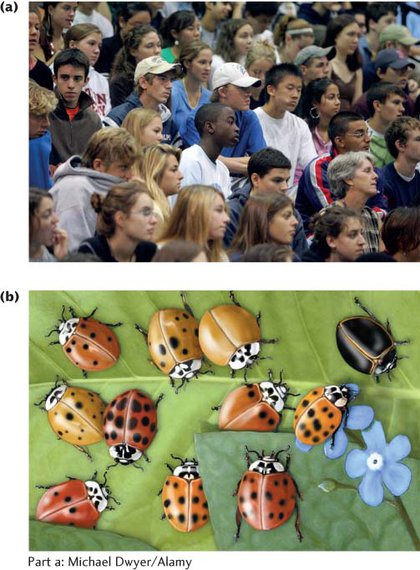18.1 Genotypic and Allelic Frequencies Are Used to Describe the Gene Pool of a Population
An obvious and pervasive feature of life is variation. Students in a typical college class vary in eye color, hair color, skin pigmentation, height, weight, facial features, blood type, and susceptibility to numerous diseases and disorders. No two students in the class are likely to be the same in appearance.
Humans are not unique in their extensive variation (Figure 18.1a); almost all organisms exhibit variation in phenotype. For instance, lady beetles are highly variable in their spotting patterns (Figure 18.1b), mice vary in body size, snails have different numbers of stripes on their shells, and plants vary in their susceptibility to pests. Much of this phenotypic variation is hereditary. Recognition of the extent of phenotypic variation led Charles Darwin to the idea of evolution through natural selection. Genetic variation is the basis of all evolution, and the extent of genetic variation within a population affects its potential to adapt to environmental change.

In fact, even more genetic variation exists in populations than is visible in the phenotype. Much variation exists at the molecular level, owing in part to the redundancy of the genetic code, which allows different codons to specify the same amino acid. Thus, two members of a population can produce the same protein even if their DNA sequences are different. DNA sequences between genes and the introns within genes do not encode proteins; much of the variation in these sequences probably also has little effect on the phenotype.
Before we can explore the evolutionary processes that shape genetic variation, we must be able to describe the genetic structure of a population. The usual way of describing the genetic structure of a population is to enumerate the types and frequencies of genotypes and alleles in that population. A frequency is simply a proportion or a percentage, usually expressed as a decimal fraction. For example, if 20% of the alleles at a particular locus in a population are A, we would say that the frequency of the A allele in the population is 0.20. For large populations, for which it is not practical to determine the genotypes of all individual members, a sample of the population is usually taken and the genotypic and allelic frequencies are calculated for this sample. The genotypic and allelic frequencies of the sample are then used to represent the gene pool of the population.